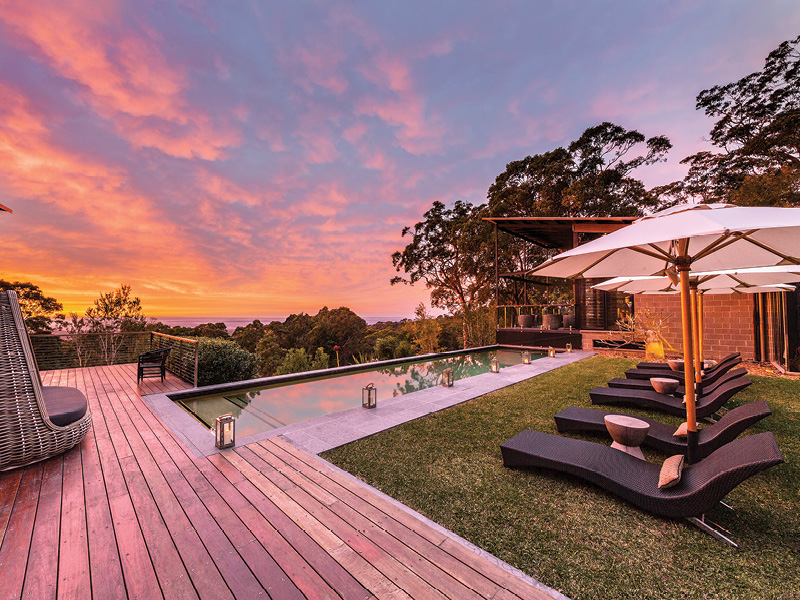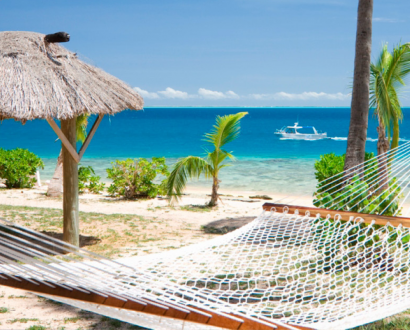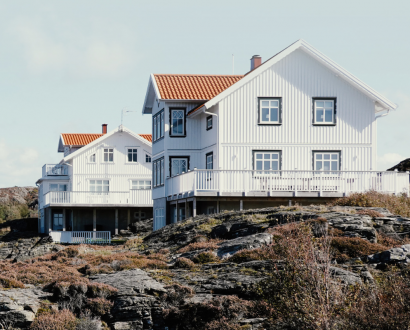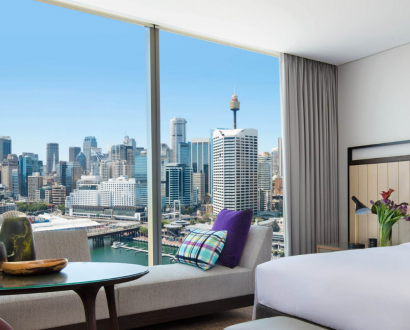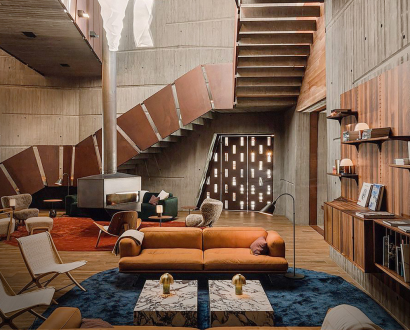As if weightless, the helicopter lifts off the flat, green expanse jutting out from the hillside, and suddenly yet smoothly the sloping land drops away, the long, green grass fanning out like undulating seagrass beneath the power of rotor blades. Looking down at Sangoma Spicers Retreat from the air, we can now fully appreciate just how well the luxury eco-certified property is discreetly tucked into the native Australian bushland and rainforest, blending in with the spectacular, fertile environment.
As we climb higher into the sky, the turquoise-blue pool stands out like a rectangular jewel, but the cabins and the main lodge almost disappear into the terrain — their stony grey and brown roofs now looking like rock ledges. If you weren’t looking for it, you wouldn’t guess that there was accommodation for 12 people hidden in the hills above Richmond, only an hour’s drive from Sydney.
We’re whisked away from Sangoma, and minutes later we’re looking down into the awe-inspiring expanse of the Blue Mountains, marvelling at the wild enormity of a region that sprawls, blue–green, across 11,400 square kilometres of New South Wales. With the Nepean and Hawkesbury rivers to the east, the Coxs River and Lake Burragorang to the west and south, and the Wolgan and Colo rivers to the north, it’s easy to understand why early European settlers eagerly delved into the resource-rich mountains in the late nineteenth century.
It was also only a few hours by horse and cart from Sydney, so year by year, with the establishment of townships and the building of roads and, later, busy train lines, a taming of its wild, gorge-ridden landscape began. Now we can see those towns and villages that later became extensions of the city and meandering urban sprawls.
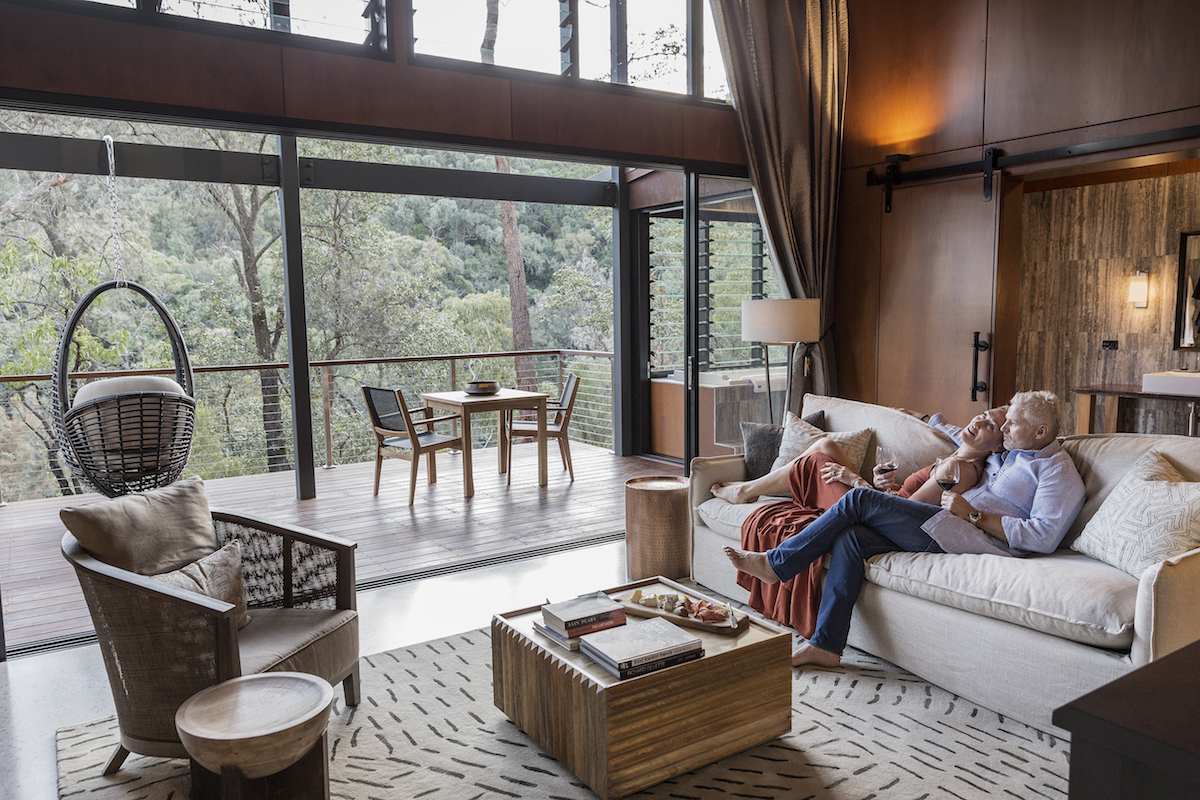
For half an hour, we explore the world below from the air, and then, like a giant butterfly gracefully landing on a bush, we settle back into the world of Sangoma. Once the blades are stilled, the serenity of the retreat envelops us. ‘Sangoma’ is the Zulu name for healer, or diviner, and the name couldn’t be more apt, as it’s the peacefulness and connection with nature that makes this space feel so special.
The retreat was created six years ago, but it was recently closed for six months for a multimillion-dollar refurbishment. The beauty of Sangoma is that it seems as though it’s always been there, blending in with the bushland. It’s modern yet earthy, stylish, artistic and homely. There are books and art aplenty, and the design aesthetic pivots on raw, natural materials, earthy colour tones, natural textures, and nature-inspired patterns, with the occasional flourish of glittering luxury captured in a crystal chandelier or the dark-brown leather studded dining chairs and patchwork animal-hide cushions.
There’s also a touch of African safari lodge, particularly in the Chief’s Suite, conveyed through African art and sculpture, and animal hides collected by the previous owners — they were big fans of the continent. All of this merges with luxurious features such as silver candelabras, freestanding baths, and touchpad lights and blinds to create a haven where total relaxation is the aim of the game.
Before the refurbishment, there were four types of suites at Sangoma — Lodge, Bush, Tent and the Chief’s Suite, which is like a two-storey townhouse. The Escarpment Suites are the latest addition, and they cling to a rugged hillside, surrounded by giant Angophora gums. Magpies, kookaburras, currawongs, lyrebirds and lizards are regular visitors, and the 80-square-metre open-plan design invites nature in. There are unhindered views over the bushland from the lounge, deck, bathroom, or from the custom-made Spicers king-size bed. Combustion stoves and heated floors mean that even during a winter getaway, cosiness is ensured.
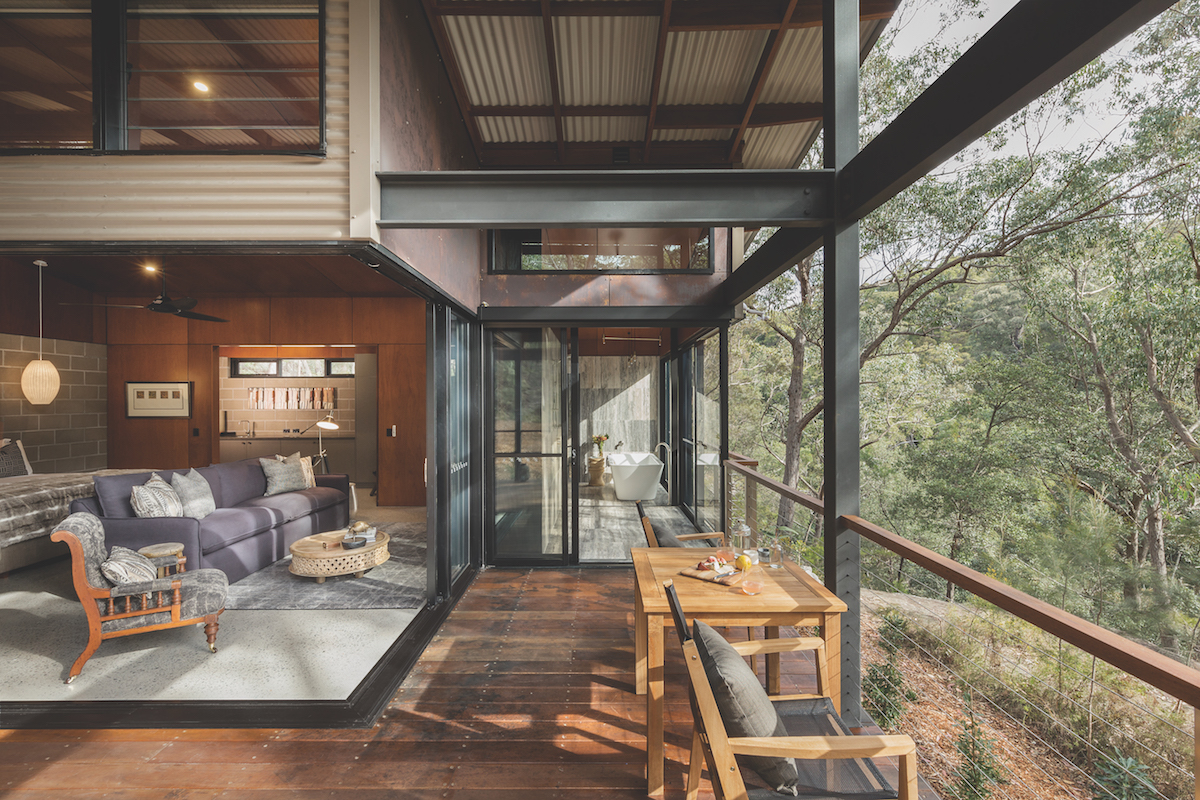
Magpies, kookaburras, currawongs, lyrebirds, and lizards are regular vistors, and the 80-square-metre open-plan design invites nature in.
The meals at Sangoma are created by Head Chef Sam Hardinge, who, as well as being an extremely talented and passionate chef who loves using the region’s abundance of fresh produce, is also friendly, entertaining, and ready to ensure a guest’s dietary needs are met, with finesse. All meals are made on the day with local fresh and mostly organic ingredients. Guests are seated in the lounge and dining area when evening falls, which again has the feel of being a private home.
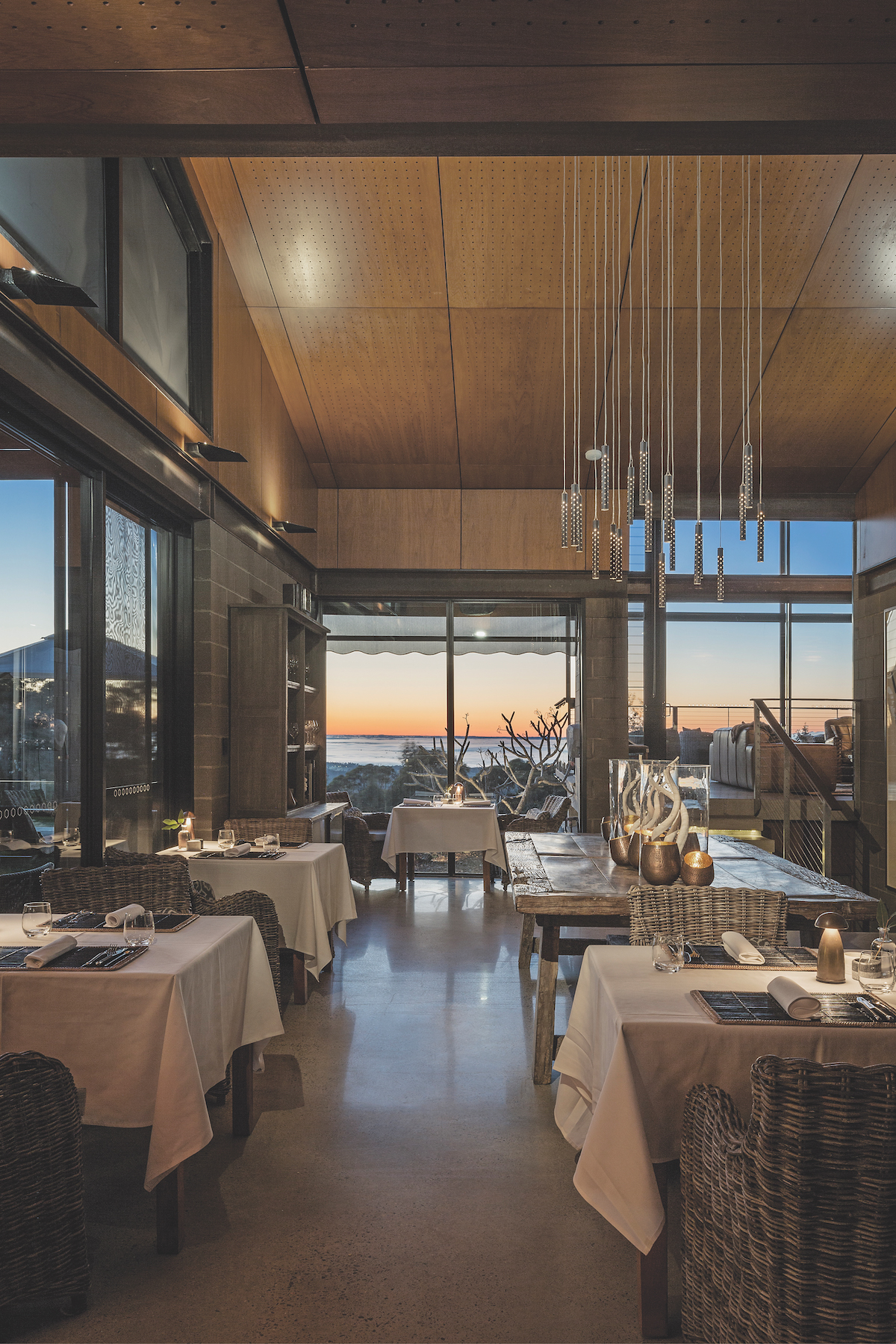
That’s because the main split-level house of the retreat was actually a private home that the owners converted into a common space once the suites were built. On warmer nights, guests can dine outside under the stars. Sam’s mouth-wateringly good menus change daily, and are artistic yet homely. He relies on the pure tastes of great local produce and then enhances the dining experience by adding some unexpected flavours and flair, often relying on what he has growing in the bush-tucker vegie patch.
An example of Sam’s creative culinary concoctions is a dish of Yarramundi carrot, Willowbrae goats curd, and red sorrel, all served atop a delicate base of beet ‘soil’ — followed by a main of succulent pork on a bed of chilli fennel, red shiso (a herb in
the mint family) and buffalo milk. He also loves surprising guests with delicate desserts that you’d be hard-pressed finding elsewhere, such as his take on muhallabieh — a Middle Eastern milk pudding — which is completed with a light sprinkling of pistachio, hibiscus and rose petals.
A new addition to Sangoma is the outdoor fire pit and outdoor lounging and dining spaces, so on a warm night, guests can sit under the stars and take in the ambience of the surrounding bushland while sipping on a cocktail or a glass of champagne. With the fire lit, it’s the perfect place for a nightcap.
Don’t leave Sangoma without treating yourself to a kahuna massage in a tent suite (complete with crystal chandelier) completely ensconced in the bush. The suite’s canvas walls have large windows that frame the bushland backdrop, and outside the zippered door a burbling water feature adds to the calming ambience. Kahuna is a therapeutic massage based on the teachings of ancient Hawaiian kahunas — ‘huna’ meaning ‘secret knowledge’.
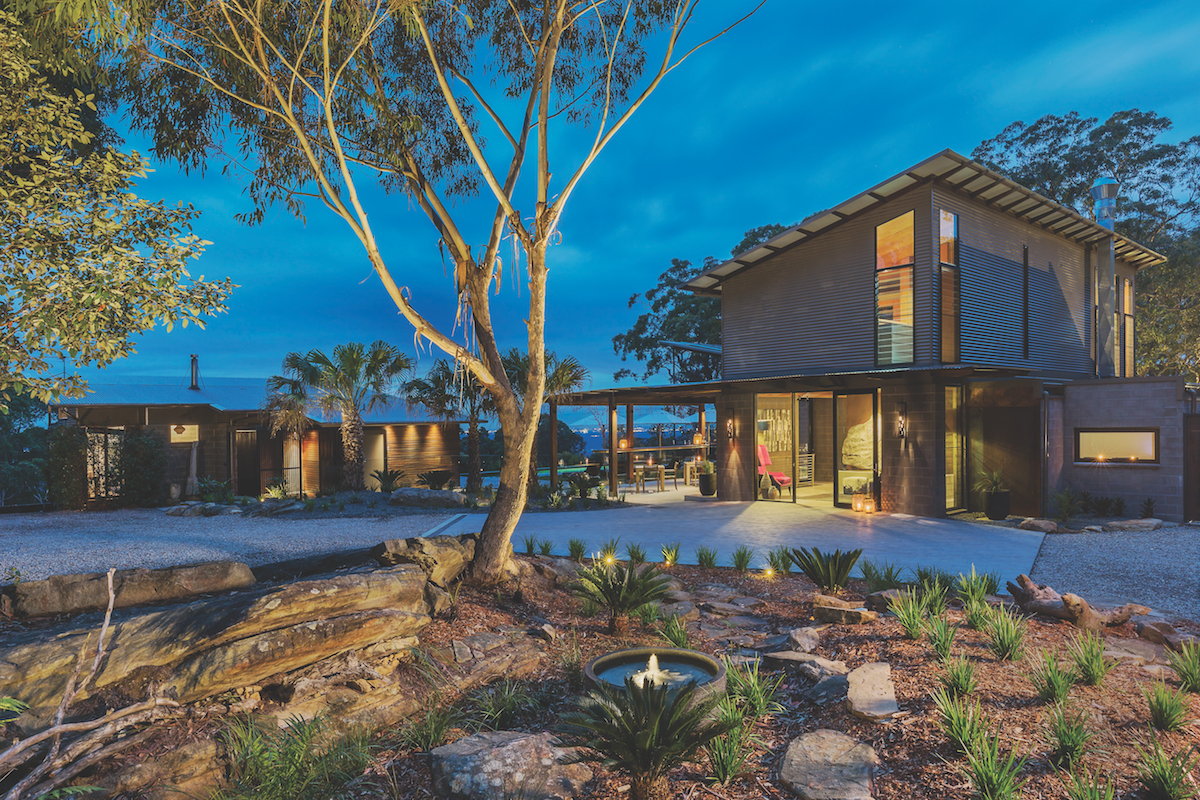
A master of the huna arts is known as a ‘kahuna’, and they practise a vigorous, rhythmic and soothing massage, using fingers, palms, wrists and forearms as they move rhythmically around the table, often chanting in a low, mesmerising way. With birdsong melding into the sound of a babbling brook outside, and your body being released of pent-up energy inside, in no time at all you’ll be lulled into something that everyone at Sangoma strives to achieve: a state of pure serenity.

